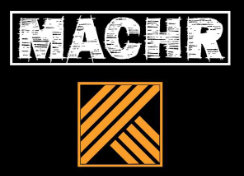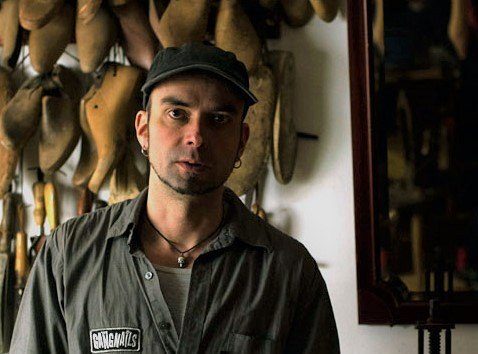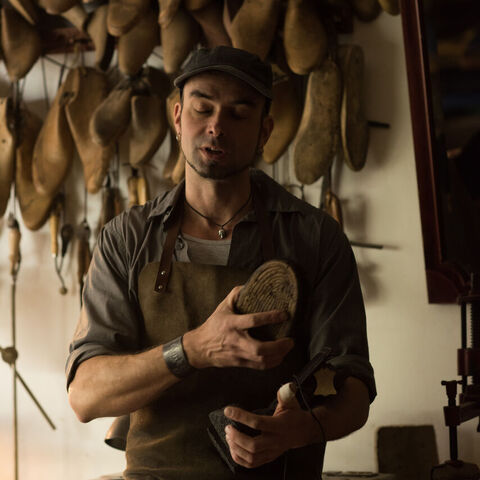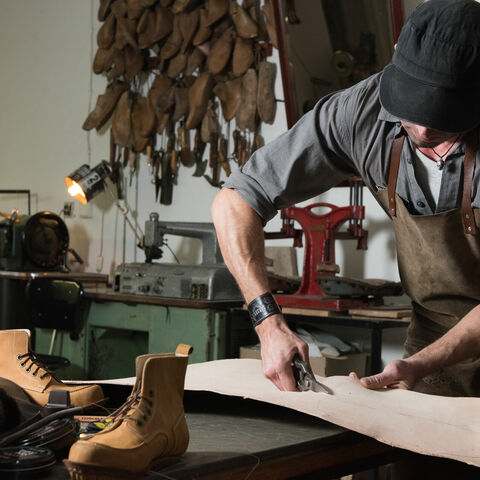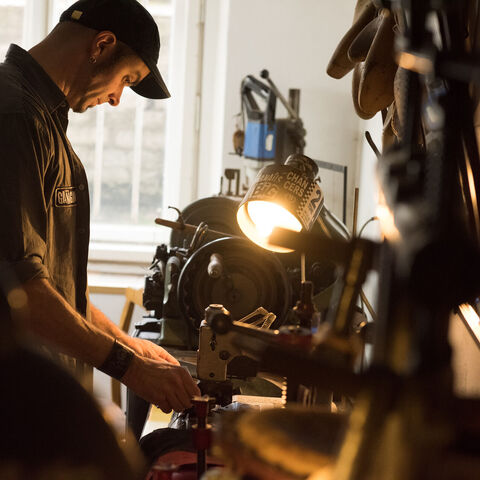How does a university graduate become a shoemaker?
Today, looking back on how I ended up in shoemaking, it doesn’t seem all that original to me. I’m just another one of those craftsmen from my generation and younger, who came to their trade by a roundabout way, studied something completely different in university, and decided to quit shortly after starting a job that was supposed to align with their previous efforts. A job that, in the end, didn’t excite or fulfill them at all.
What didn’t excite you? What did you actually study, and why didn’t you take a lucrative engineering job?
I studied biomechanics and endoprosthetics, focusing on the lower limb movement apparatus and the replacement of skeletal system elements. It was mainly about algorithmic modeling of orthopedic problems into a system, loading it, running finite element method calculations using software, and then analyzing and implementing it. Contrary to expectations, I found that the field wasn’t as creative as I had hoped. Plus, I wasn’t exactly a genius at it.
How did you solve that?
Pretty quickly after I started my job post-graduation, I realized that sitting in front of a monitor at a software company with a blank expression on my face wasn’t for me. I realized I didn’t want to be there, that I’d rather flip the desk, throw my phone and keys away, and hide in the woods and rocks. Then, at just the right moment, I saw Vorel’s Cesta z města (The Way Out of the City), and the next day, I didn’t return to the office. I shaved my head and swapped my office job for manual work.
That’s quite a radical decision. But let's get back to your current profession. How do you explain the disinterest in shoemaking?
There used to be a shoemaker on every street. Today, there are very few who can match the masters who used to craft beautiful, perfectly made boots, laces, or brogues. The highest level of shoemaking was reached around one hundred, one hundred and fifty years ago.
Ben Hrubeš
|
How does it differ from today?
When you take a piece of footwear from that time and look closely at the stitching, the arrangement of the parts, the shape, the intricate decoration, and the clean finish, you'll realize that it approaches perfection—and sometimes it is indeed perfect.
It's unbelievable that such shoes were made by illiterate people without machines, just using a needle, thread, and a knife, without glue, rubber soles, synthetic threads, thermoplastics, polyurethanes, and other components that today's shoe production depends on. And yet, some of these shoes survived through a war and are still functional. I know a few enthusiasts who still wear these so-called "Raitsh" boots daily.
How is that possible?
The industrial and chemical revolution gave rise to manufactories, rationalized human resources, divided tasks, and introduced new materials and specialized machines. Traditional shoemakers began to be replaced early in the 20th century by large manufacturers like Baťa, and communists essentially finished off this craft.
Nevertheless, this craft still survives, although in very limited form. You're proof of that, aren't you?
In the 1990s, a few pioneers appeared, and the most persistent among them contributed to the revival of shoemaking, literally lifting it from the ashes. People gradually realized that it was possible to have shoes custom-made that were truly high quality and comfortable.
Where did you learn to make shoes?
Although I came from humble beginnings, we had an old shoemaking machine at home. My dad used it to make BMX pads and pants. I always enjoyed stepping on it, spinning the flywheel, rocking the arm, and pushing the foot, later I was fascinated by its intricate Art Nouveau mechanics. I started figuring out what it could do and what it needed.
Shortly after elementary school, my first failed creations started to appear. They were used on hiking trips in the style of Conan, The Witcher, Hobbit, and Dungeons & Dragons. This period of adolescence had a strong influence on me, and in just a few years, I was shaped into who I am now.
That's nice. Usually, this period is associated with self-discovery, drugs, alcohol, and so on.
We weren't spared from drugs, sniffing toluene, and drinking excessively, but I guess I was lucky. Thanks to the wild enthusiasm of a group of boys, we all did something creative, like crafting, cutting, filing, sewing, forging, painting, building, and inventing. It was the quintessence of creative inspiration, creating a world according to our own rules. I became obsessed with working with leather and wanted to make shoes. It was a long journey, more of a labyrinth with many dead ends.
But on this journey, you needed quality guidance. Did you find it?
When I started, there was no one to learn from. No one remembered how to properly sew shoes. But I had enough conviction, desire, and energy to push through, uncover forgotten tools, and eventually, I managed to turn myself into a shoemaker.
What did you need to get to be a complete shoemaker, with all the necessary tools?
I tried around thirty different machines, and in my workshop, I have five sewing machines that I actively use, plus three backups. My machines are fine-tuned to match my personality. I also own large and small grinders, two hand presses for soles, a heap of old hand tools, hundreds of shoe lasts, and millions of cattle hides.
How did it go with finding suitable space for your work?
The very beginning was in a panel apartment room, and later I rented a garage in Nusle during my studies. It had no heating or windows. In the lean years, after deciding to go my own way, I was taken in by my girlfriend's parents, now my wife, in a room in a villa in Hanspaulka. Then I sewed in a squat in Břetislavka, and eventually, I settled in a workshop not far from where I live. I've been there for fifteen years, with two years of making historical footwear in larger manufacturing spaces.
But currently, the clouds are gathering over the rent of my charming little shoemaking shop with a garden, and I'm starting to look for another space. When I retire, I plan to move to the wilds of the Šluknov region.
Do you still remember your first shoes? What were they like?
They looked dreadful. They were supposed to be gothic pointed boots made from old pants, with a sole made from linoleum and copper strips for decoration. From today's perspective, it was a complete disaster, but I'm still amazed when I meet people who are enthusiastic about my early work. My view has been shaped by years of work and expertise, and now I see craftsmanship as the art of mastering a skill.
Has the type of footwear you make changed over time? Did it evolve based on demand?
From the start, I made shoes for historical costumes. This kind of footwear was not available. First for myself, for my friends, and then for a wider group of enthusiasts. It spread that Hrubeš makes affordable shoes for fencing, and since then, I have never lacked orders. Historical fencing has become a mass hobby in our country, and since we began, it has improved significantly in quality.
I started to delve into the construction, design, cut, and technological principles of footwear. The medieval shoes I made turned out to be a great school. Afterward, I ventured into increasingly complex models, spanning from antiquity to the Baroque period. By then, I had so many orders that I began collaborating with other leatherworkers and looking for an apprentice.
Did you find one?
Eventually, I found a sufficiently persistent, eager, and extremely hardworking apprentice named Lucas, a fan of Vikings and entrepreneurship. The production grew, as did the number of orders, and the original workshop couldn't keep up, so we moved to bigger premises in Letná. There, we were four, optimizing production, dividing tasks, and equipping the workshop with more machines and materials.
Are you still there?
After a while, this business model started to bore me. It ceased to be a creative artistic job, and I felt I was stagnating. The business was running fine, but I wasn’t enjoying it. At the same time, I started organizing the first shoemaking workshops, and it became technically difficult to reconcile that with running the workshop. Successful business was tying down my spirit, and my desire for personal growth was stronger, so I left Letná and left the historical footwear business to Lucas.
And what about you?
I returned to Hanspaulka, where I needed to take a break from people and sew according to my own desires. I worked my way toward making modern shoes for everyday use and high-end shoemaking—formal loafers, pumps, and boots—purely custom footwear.
What matters when selecting leather?
Leather is the foundation of a good shoe. Understanding its properties, being able to select a high-quality steer or heifer, and knowing how to read it is an alchemy that cannot be explained or tabulated. Every tannery has its own process, and the tanning recipes are secret. Just like a carpenter with wood or a sculptor with stone, a shoemaker relies mostly on intuition when selecting leather for a given project. So the most important thing is the leather, then the construction, shape, design, and colors. Decorative details like stripes, cats in flight, and stars in circles come last.
How do you feel about all these e-shops with "the best" shoes? What should a customer keep in mind when choosing them?
I don’t have the courage to say that my shoes are the best. There’s always something to improve, but I make them the best I can, and that’s enough. When it comes to footwear from commercial chains stamped with the logo of a multinational company, I would advise you to look closely at them and compare their price with sneakers from a Vietnamese market. The quality is about the same, but the price is dramatically different.
Just like the unbranded ones, those branded shoes were made in Asia with cheap materials by poorly paid workers. The design and intellectual property of the industrial pattern is a dubious matter, and it absolutely doesn’t match the difference in quality and price. Trust me, I know something about this, and I recommend you check out the worthwhile project "The Story of Shoes."
What do you make? How long does it take to make a pair of shoes, like classic moccasins or pumps?
Mastering the shoemaking craft requires a lot of experience, skill, and the right tools, machines, and materials, many of which won't fit in a single room. Classic formal shoes or women's pumps are works that only a handful of experts in the Czech Republic can handle—about ten to twelve people.
Why? It's a precise, highly specialized job that requires constant honing. If we talk about how long it takes to make a pair of custom shoes, it can range from ten to forty hours, depending on the type.
I know you also run workshops where people can make their own shoes. How does that work?
The hardest part is getting into my workshop. Every time I announce the dates a year ahead, they get booked up within half a day. I hold workshops twice a month, designed as two very intense days for two participants, who leave with their own handmade pair under my guidance.
Can you make a living from this work nowadays? Do you do anything else?
Even just a fraction of this field would be enough to support me, whether it’s holding workshops, making shoes for fashion boutiques, repairing shoes, renting lasts, consulting, or assembling kits for public shoemaking. I have a broad range of skills and try to master making various types of shoes. I love a diverse life, and routine drains me. It's a shame that time flies so quickly in the workshop.
You have children. Do you want to raise them as your successors?
I have two sons with my wonderful wife. To make me happy, my younger one says he wants to be a




